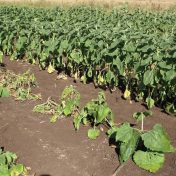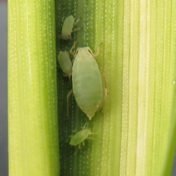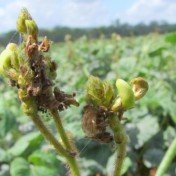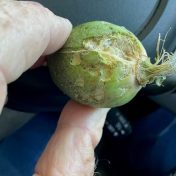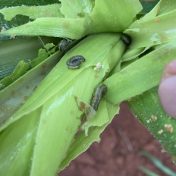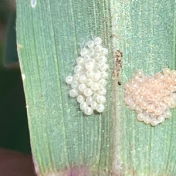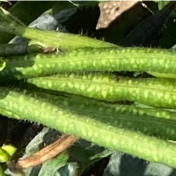The DAF plant pathology team has recently identified powdery mildew and downy mildew from soybean crops growing in the Mackay region. Powdery mildew in soybean is caused by the fungus Erysiphe diffusa. This air-borne pathogen thrives in cool, humid weather. Infected plants develop symptoms initially on older leaves in the lower canopy. Whitish grey powdery patches develop on the upper… Read more »
The recent declaration of El Niño conditions for eastern Australia means an increased chance of below average rainfall. Historically, these conditions can lead to more severe outbreaks of tobacco streak virus. However, with forward planning and selection of suitable sunflower hybrids, the risk of economic impacts from TSV can be avoided. If sunflowers crops are planned for early 2024 in… Read more »
Detections of Russian wheat aphid Diuraphis noxia (RWA) in New South Wales appeared later than usual this year. RWA was detected in Tambar Springs in northern New South Wales (NSW) in August 2023, followed by detections in the Liverpool Plains, Trangie and Moree Plains. More than 60 cereal and grass samples were collected in northern NSW between April and July… Read more »
A new APVMA permit (PER 93132) allows the use of a spray drift management tool (SDMT) to re-calculate buffer zones to suit your particular situation when applying some pesticides. The SDMT (available as a spreadsheet file) and other relevant documentation (including a video on how to use the calculator) and a copy of PER93132 can be found on the APVMA… Read more »
There have been several reports of Fusarium wilt affecting mungbean paddocks throughout southern Queensland within the last couple of weeks. Monitor crops closely for disease symptoms, and contact our plant pathologist, Lisa Kelly at [email protected] or 0477 747 040 for further information on disease diagnosis. Minimise the spread of the disease by avoiding movement through infected paddocks and thoroughly removing… Read more »
There have been reports of mice activity in some crops around the Central Highlands, including grain sorghum, mungbean and cotton. Numbers of house mice (Mus domesticus) are generally low in cropping areas, but plagues can occur when conditions are favourable. Mouse populations have the potential to build rapidly and can do considerable damage in high numbers. Controlling plagues is both… Read more »
Powdery mildew has been detected in several mungbean crops growing in southern Queensland within the last couple of weeks. Powdery mildew in mungbean is caused by the fungal species, Podosphaera xanthii and Erysiphe vignae. Two fungicide options are currently under permit to manage the disease, including tebuconazole products (PER13979 – download the permit from the APVMA portal for more details… Read more »
If you are managing fall armyworm (FAW) in maize, you may have noticed that the permit for Affirm® (emamectin benzoate) (PER93226) had disappeared from the APVMA permits portal. PER93226 was temporarily suspended whilst clarification was sought around withholding period (WHP) and use patterns. While PER93226 is now back on the APVMA permits list, it is important to note it has… Read more »
Fall armyworm (FAW) moth catches have increased significantly in some regions over the past few weeks (see trapping counts below). It is unclear whether this increase in trap catches is indicative of migration events (perhaps associated with the recent storm activity) or increasing night temperatures that allow for greater movement of moths that may have emerged locally. Very low densities… Read more »
A severe outbreak of phytoplasma disease has been reported in mungbeans from the Burdekin region. Symptoms of little leaf, phyllody (greening of flower structures) and puffy pod became obvious in mid-late October and have now affected a high incidence of plants in a 25 ha planting. Puffy pod affected plants typically remain green for longer than healthy mature plants. This… Read more »


